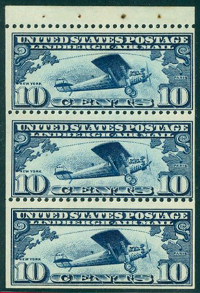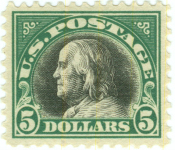
Discussion - Member to Member Sales - Research Center

Discussion - Member to Member Sales - Research Center



Login to Like
this post
Dear Oatmealsizzle- you have stumbled upon a hidden right of passage. To be worthy of being a stampcollector, one must show that they are foolhardy, courageous to the extreme, and nuts.
These series are part of that ancient and sacred ritual. There are others of course, but you are not yet permitted to become aware of them. Your dedication to the endeavor must first be shown. This hobby is not for the fainthearted- and can last a lifetime.
Be warned!!
Best,
Dan C.

5 Members
like this post.
Login to Like.

01:17:53pm
There is another way to collect which just involves collecting the picture on the stamp - no varieties. I know very little about it since that is not the way I collect, but I believe catalogs and albums exist for people who collect this way. Is it not Stanley Gibbons who publishes the catalog? I'm sure someone out there can supply the answer. I like the varieties even though my patience for detecting them is starting to disappear.

1 Member
likes this post.
Login to Like.
Oatmeal,
there are tons of varieties of these stamps, collectively called Washington/Franklins (sometimes written as W/F). Varities are caused because different papers were used with different watermaks; they were divided into different sizes (sheets, booklets, coils) printed on different types of presses (rotary and flat); and separated in different ways (different perfs, private perfs, and no perfs). Several different dies were used on the plates.
They are not the same, but they look pretty much so (kind of like snowflakes; all different, but who can tell).
Like Harvey says, collect one of each denomination or try to sort through them by varieties.

Login to Like
this post
" I believe catalogs and albums exist for people who collect this way. Is it not Stanley Gibbons who publishes the catalog?"
Yes. It is called "Stamps of the World" Catalogue.
While this catalogue set only lists face different stamps, including colors, there is another good use for it regarding newer issues. For some time, Scott has listed only sets for most new issues. Gibbons lists the stamps in each set separately, so it is possible to know which stamps belong in the set. Also, you can get a good idea of what the catalogue value of each stamp would be for the Scott catalogue number for each stamp.

Login to Like
this post
"The Stamps of the World" Catalogue by Stanley Gibbons is produced every year and runs to six volumes and currently costs £249 for the 2019 Set.
The catalogue is a reasonable guide. It does not differentiate between watermarks or colour shades.
The prices it quotes can be disengenious. If there were three types of the same value, the same colour, but different watermarmarks it only lists one price. Sometimes they price the more common type other times they price the rarest of the three
I have seen stamps listed at $20.00 and that is the price for the rarest of the three when the more common of the three types is priced at 20 cents and vice versa.
The reader does not know what type the price listed relates to.

Login to Like
this post

06:25:31pm
Ian, I'm an old retired math ( in your "language", maths ) teacher. They should do something called a weighted pricing which takes into account all the variations of each stamp and the rarity and price of each. If they don't want to take the time to carry out this complicated calculation they really should use the most common stamp.

Login to Like
this post
The U.S. dealers know the difference but how often do i speak to a U.S. dealer ?

Login to Like
this post
"Why are there so many versions if they all look alike?"
The W/F stamp series was a long running series during a time when stamp production was seeing many advances/changes in production methods. At the time, not all collectors were paying attention to these production changes and many were not actively chasing down the varieties.
In many ways this is very similar to the current 'tagging' varieties of today.
Don

Login to Like
this post

11:48:21am
The worst part of these stamps is determining the watermark. Two line watermarks are fairly straight forward. Sometimes a one lined watermark may just touch a stamp in one small area and it's very hard to find, making you think the stamp is unwatermarked. Colour shades can also be difficult if the stamp is faded a bit. And that's only the beginning, I can remember spending over an hour on a stamp and still putting it in the album with a "?" next to the number. You have to be very patient and as I get older that seems to be a problem!

3 Members
like this post.
Login to Like.
"They should do something called a weighted pricing which takes into account all the variations of each stamp and the rarity and price of each. If they don't want to take the time to carry out this complicated calculation they really should use the most common stamp."
Unforunately they don't.
Please remember that Stanley Gibbons main business is to sell stamps and their catalogues are their price lists.

Login to Like
this post
12:41:39pm
These are confusing. Why are there so many versions if they all look alike?!?

Login to Like
this post

re: 2¢ Washington Head
Dear Oatmealsizzle- you have stumbled upon a hidden right of passage. To be worthy of being a stampcollector, one must show that they are foolhardy, courageous to the extreme, and nuts.
These series are part of that ancient and sacred ritual. There are others of course, but you are not yet permitted to become aware of them. Your dedication to the endeavor must first be shown. This hobby is not for the fainthearted- and can last a lifetime.
Be warned!!
Best,
Dan C.

5 Members
like this post.
Login to Like.
Back when I had a bunch! I think, therefore I am - I think! Descartes, sort of!
23 Sep 2020
01:17:53pm
re: 2¢ Washington Head
There is another way to collect which just involves collecting the picture on the stamp - no varieties. I know very little about it since that is not the way I collect, but I believe catalogs and albums exist for people who collect this way. Is it not Stanley Gibbons who publishes the catalog? I'm sure someone out there can supply the answer. I like the varieties even though my patience for detecting them is starting to disappear.

1 Member
likes this post.
Login to Like.
re: 2¢ Washington Head
Oatmeal,
there are tons of varieties of these stamps, collectively called Washington/Franklins (sometimes written as W/F). Varities are caused because different papers were used with different watermaks; they were divided into different sizes (sheets, booklets, coils) printed on different types of presses (rotary and flat); and separated in different ways (different perfs, private perfs, and no perfs). Several different dies were used on the plates.
They are not the same, but they look pretty much so (kind of like snowflakes; all different, but who can tell).
Like Harvey says, collect one of each denomination or try to sort through them by varieties.

Login to Like
this post

re: 2¢ Washington Head
" I believe catalogs and albums exist for people who collect this way. Is it not Stanley Gibbons who publishes the catalog?"
Yes. It is called "Stamps of the World" Catalogue.
While this catalogue set only lists face different stamps, including colors, there is another good use for it regarding newer issues. For some time, Scott has listed only sets for most new issues. Gibbons lists the stamps in each set separately, so it is possible to know which stamps belong in the set. Also, you can get a good idea of what the catalogue value of each stamp would be for the Scott catalogue number for each stamp.

Login to Like
this post
06:18:06pm
re: 2¢ Washington Head
"The Stamps of the World" Catalogue by Stanley Gibbons is produced every year and runs to six volumes and currently costs £249 for the 2019 Set.
The catalogue is a reasonable guide. It does not differentiate between watermarks or colour shades.
The prices it quotes can be disengenious. If there were three types of the same value, the same colour, but different watermarmarks it only lists one price. Sometimes they price the more common type other times they price the rarest of the three
I have seen stamps listed at $20.00 and that is the price for the rarest of the three when the more common of the three types is priced at 20 cents and vice versa.
The reader does not know what type the price listed relates to.

Login to Like
this post
Back when I had a bunch! I think, therefore I am - I think! Descartes, sort of!
23 Sep 2020
06:25:31pm
re: 2¢ Washington Head
Ian, I'm an old retired math ( in your "language", maths ) teacher. They should do something called a weighted pricing which takes into account all the variations of each stamp and the rarity and price of each. If they don't want to take the time to carry out this complicated calculation they really should use the most common stamp.

Login to Like
this post

re: 2¢ Washington Head
The U.S. dealers know the difference but how often do i speak to a U.S. dealer ?

Login to Like
this post

re: 2¢ Washington Head
"Why are there so many versions if they all look alike?"
The W/F stamp series was a long running series during a time when stamp production was seeing many advances/changes in production methods. At the time, not all collectors were paying attention to these production changes and many were not actively chasing down the varieties.
In many ways this is very similar to the current 'tagging' varieties of today.
Don

Login to Like
this post
Back when I had a bunch! I think, therefore I am - I think! Descartes, sort of!
24 Sep 2020
11:48:21am
re: 2¢ Washington Head
The worst part of these stamps is determining the watermark. Two line watermarks are fairly straight forward. Sometimes a one lined watermark may just touch a stamp in one small area and it's very hard to find, making you think the stamp is unwatermarked. Colour shades can also be difficult if the stamp is faded a bit. And that's only the beginning, I can remember spending over an hour on a stamp and still putting it in the album with a "?" next to the number. You have to be very patient and as I get older that seems to be a problem!

3 Members
like this post.
Login to Like.
06:07:57pm
re: 2¢ Washington Head
"They should do something called a weighted pricing which takes into account all the variations of each stamp and the rarity and price of each. If they don't want to take the time to carry out this complicated calculation they really should use the most common stamp."
Unforunately they don't.
Please remember that Stanley Gibbons main business is to sell stamps and their catalogues are their price lists.

Login to Like
this post

